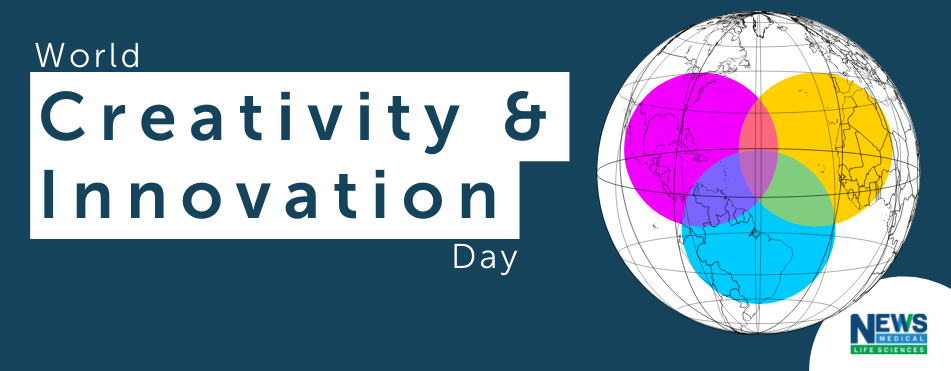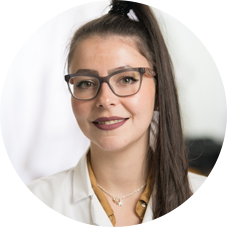
Every year, the United Nations celebrates World Creativity and Innovation Day. The aim of this day is to help raise awareness of the role that creativity and innovation has within all aspects of human development.
AZoLifeSciences aims to share life sciences with the world and with people who can make a difference. This year, we asked leading experts within the life sciences industry 'What does creativity and innovation look like to you within science?' to show the diversity in responses across the sector and what the future looks like for research. Read their thoughts below!
Michelle Egger, Co-Founder, and CEO of BIOMILQ
My name's Michelle Egger and I'm the co-founder and CEO of BIOMILQ. We are leveraging next-generation science to fuel our next generation. Utilizing human mammary epithelial cells to create milk outside of the body is pretty innovative and the fact that we are pulling from technology that's existed for decades, but applying it in a new manner, we often get asked, "How hasn't this happened before? Why hasn't somebody thought to make milk utilizing this system?"
I think women who are inspired and educated in a highly STEM deep tech field, who are inspired to use their capabilities for good to create impact in the world bring innovations like this to market. We are focusing on a problem, infant nutrition and breastfeeding, where there isn't enough discussion about how difficult it is and how many women and families it impacts.
We are also proud to be able to work on a problem that's both technically really challenging, but also societally and culturally really important. That wouldn't have come about if we hadn't had women who have been trained to be able to address problems like this.
Michael Weingarten, Director of the National Cancer Institute's Small Business Innovation Research Program
My name is Michael Weingarten and I'm the director of the National Cancer Institute's Small Business Innovation Research (SBIR) Program. In terms of creativity, we are always looking at where we can have the greatest kinds of impacts, both in terms of technology developments and also in terms of the resources that we offer to a small business. That includes funding the next generation of technologies that can really have an impact on the field, whether that be in drug development, in diagnosing cancers earlier, and a whole range of strategies for how we go about treating those cancers. So we are always looking to fund that next innovation that's really going to have an impact on the patient.
In addition to that, creativity also involves looking at the needs that our companies have for all these young startup companies as they have a range of needs. That includes providing, for example, connections with investors because with the SBIR program, we provide that early-stage funding from the government where we're willing to take on a risk that maybe the private sector wouldn't take on. That's what makes the SBIR program different and special is we fund very high-risk, early-stage research.
As these technologies in these companies advance, they need to be able to also raise investor capital to move that technology towards commercialization. Therefore, over the last 15 years, we've actually developed relationships with all the major investors in cancer, in the private sector. We help to connect our early state small businesses with those investors so that our companies can then help raise the capital they need to move their promising technologies all the way to commercialization, and ultimately towards patients.
Another thing that we do is provide key access, for example, to training the small business needs. We run a program called I-Corps (Innovation Corps), which teaches companies how to build a business model around the technology that they've developed. For academic innovators, that's important because they spent all their time in the labs, they need to learn about how you go about running a business and how you do not just develop that technology, but how you move that technology to the marketplace? Those are just some examples of how we impact creativity.

Image Credit: Triff/Shutterstock.com
Dr. Noemi Procopio, Senior Research Fellow in Forensic Science, Northumbria University
I am Dr. Noemi Procopio and I am a Senior Research Fellow in Forensic Science at Northumbria University in Newcastle, and I'm also a UKRI Future Leaders Fellow. When thinking about what creativity and innovation mean to me within science, the question made me think about what I think makes science so incredible, and I realized for me, there are two main factors.
On one side, science is completely driven by curiosity. To me, curiosity is the main driver of creativity and innovation. When you apply curiosity to science, there are no limits to developing knowledge and innovation. That's why to me, being a scientist is such an incredible opportunity to be curious and to make change possible.
The second factor that makes science so great for me is the fact that with the help of creativity, you can turn any downside of your experiments, your projects, your results into a positive, into an advantage that can guide you to new experiments, to new projects, and new knowledge. Therefore, the main secret, in this case, is to keep your mind open, be ready for new challenges, and be constantly optimistic.
Dr. Toby Kiers, Co-Founder, SPUN
We founded SPUN, which stands for the Society for the Protection of Underground Networks, to build the first maps of these vast underground fungal networks that connect ecosystems and move nutrients. For us, innovation means looking at something a bit differently. I think in conservation and climate agendas, people tend to have this aboveground bias. They focus on ecosystems above the earth that they can see.
Therefore, for us, innovation means focusing on something you can't see, these hidden networks that are incredibly important for sequestering carbon and moving nutrients around ecosystems. What we are aiming to do is start protecting underground ecosystems for the things that we can't see but that are helping regulate the climate.

Image Credit: PeachShutterStock/Shutterstock.com
Amy Wu, Director and Chief Content Director, From Farms to Incubators
I’m Amy Wu, Founder and Chief Content Director of From Farms to Incubators. As I focus on telling the stories of women innovators in this growing space called agrifood tech, creativity, innovation, and science, all are really critical to ag tech. Number one, a lot of the women, innovators, and entrepreneurs in this space have backgrounds in science, technology, engineering, and math. They have the skillset already of that, whether it was learned in high school, college, university and applied in the businesses that they worked in before they started their own companies.
Creativity is important also because one needs that to see out of the box. The women that I write about, interview, and document, looked at the world of agriculture and said, "What are some of the problems that farmers are facing? And how can I use my skills in science, technology, engineering, and math to create something tangible, to solve that problem?"
Whether it be creating a soil testing kit that looks at the DNA of the soil, creating a robot that can pick certain kinds of fruit in a certain way, or using blockchain to monitor and track food from the field to the shelf, they all have to have a combination of both to be successful. You can't just have innovation solely and you can't just have creativity on its own. I think that science on its own also doesn't work either.
Finally, innovation, as I see it, is not simply just the “product itself”. It's thinking about ways to make it all happen, so you need to actually be very entrepreneurial. I see that a very good entrepreneur can use many innovative ways to make it happen, whether it be creating a team or getting other people on board to also make it happen. No woman is an island.
Professor Dilip Jeste, Director of the Center for Healthy Aging, University of California San Diego
Regarding the question of creativity and innovation, we should start with definitions. Creativity means developing a new idea or concept. Innovation means implementing that new idea or concept. The two are related, but they are not the same. For example, the thought that a person can fly was a creative idea when it was first presented. Subsequently, engineers and others developed airplanes so that people could fly - that was an innovation.
I'm going to talk about a couple of constructs that are both creative and innovative in my field, which is the field of aging, mental health, and brain health. It is interesting that both these ideas are really not new, but have recently been accepted as scientifically validated ideas.
The first idea is that the brain can continue to grow in old age. Why it is a creative idea? Most people think about aging as all gloom and doom. Everything declines with age, including the brain. But in the last 30 years, the idea that the brain can continue to grow in old age is being increasingly accepted.
How do you first make a creative idea acceptable to others? You have to create and demonstrate that your idea is valid. In the case of aging of the brain, some scientists have conducted studies with brain imaging. Others have studied neurophysiology, the functioning of the brain in older age. There have also been animal studies of the brain in older vs. younger animals. With these studies, the concept of what is called neuroplasticity of aging has been largely accepted, and now the question is about its implementation.
The goal for implementation would be finding ways of promoting neuroplasticity of aging - i.e., how do you make older people help their own brains grow? There have now been studies on physical exercise, mental exercise, and cognitive stimulation, which show that yes, the brain can improve its function and even structure in old age if you keep those activities. This has been shown in animals and humans.
Recent studies have shown that even things like meditation and mindfulness help to improve the biomarkers of aging. Recently, there have been studies on brain stimulation and there is something called rTMS. This stands for repetitive Transcranial Magnetic Stimulation. What is done here, is stimulating the brain, not using electricity, but using magnetic fields. With that, you can stimulate specific parts of the brain, promoting neuroplasticity. Finally, some drugs can also help to improve neuroplasticity. At this time, we really don't have any safe drugs of that kind, however, I expect that within the next decade or so, there will be some such substances that will be available.
The second idea I want to talk about in terms of creativity and innovation is social connections. If you have good social support, good friendships, and good social connections, you're going to do better. However, people did not think of this as a true scientific idea. In the last 25 years, there has been increased research on social determinants of health. These are social factors that impact health and even longevity including; education, finances, neighborhood, climate, and so on. Perhaps the most important social determinant of health is social connections, the relationships we have with other people, the number of relationships, and, more importantly, the quality of those relationships. If we don't have them, we become lonely and socially isolated, and that loneliness and social isolation increase the risk of heart disease, stroke, diabetes, obesity, dementia, depression, and death. Now, there is research that shows social connections are important in animals as well as in humans.
The first part of innovation here was to demonstrate that the idea was valid. Scientists have looked at animals and humans and conducted studies using various biomarkers, imaging, and other technologies that have shown that people with social connections do better than those without. Now, some interventions are being developed to promote social connections. These may include psychosocial interventions, psychotherapy, and medications. For example, some hormones are useful for improving social connectivity. Technology can also promote social connections. Social media is one example of that, but other examples are also coming into play.
I would also like to include some general comments about creativity and innovation. There are two steps involved in promoting this. The first step is demonstrating the validity of the creative idea that it is real, and you can show it objectively. The second part, which relates to innovation, is the implementation to develop interventions that will promote that creative construct in different people.
There are some barriers to both creativity and innovation. A major barrier initially is resistance to the concept that you are proposing. You can expect that there will be people around you who will laugh at your idea, they will dismiss it. There will be skepticism and that is useful because you can understand why people have difficulty in believing in that idea, and so you can then develop ways in which you can counter that criticism.
Sometimes the risk is that you then go to the other extreme, where you so strongly believe in your idea that you don't think it has any limitations, and that doesn't help because any creative idea has limitations, and if you don't accept the limitations, the idea is going to fail. What is needed is open-mindedness. You have a creative idea, you are innovating and implementing it, but be open to listening to criticism and understanding its limitations. You can then improve it.
Finally, I believe that creativity and innovation require wisdom. If you look at the components of wisdom, you'll find out how that is true. One component of wisdom is self-reflection, the ability to look inward and realize what you are thinking. The second component of wisdom is emotional regulation. It is great to get excited about a creative idea and it is common to get depressed when the idea doesn't work, but you need to have a balance between the two. The third is pro-social behavior, empathy, and compassion because the creative idea should be used to improve people's lives. The fourth component of wisdom that is important here is accepting uncertainty and diversity of perspectives. You have to be decisive when needed and you have to act on your ideas. If they don't work, you can move on to something else.
I believe that creativity and innovation are critical for human growth and development, not just for surviving, but for thriving and flourishing.
What does Creativity and Innovation mean to you?
What does Creativity and Innovation mean to you? from AZoNetwork on Vimeo.